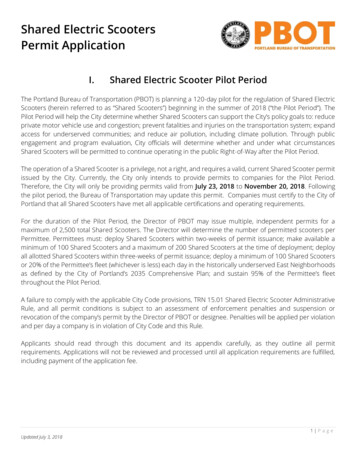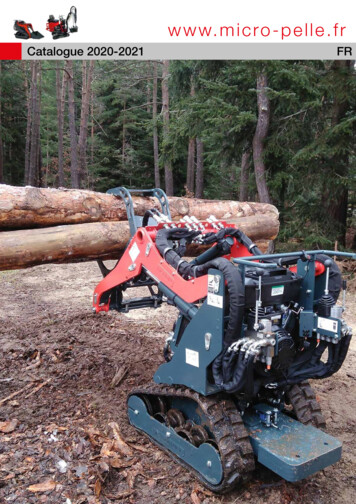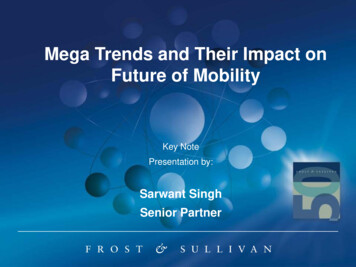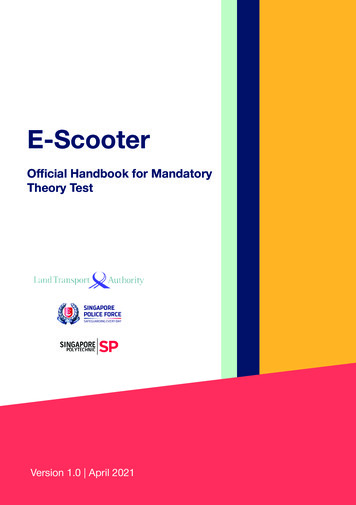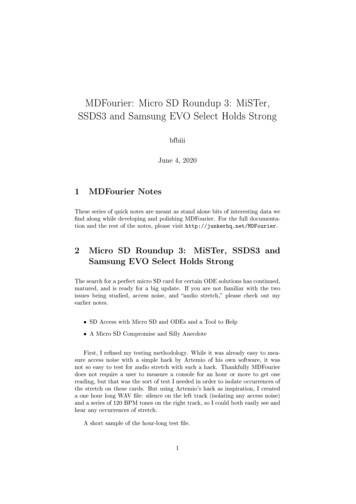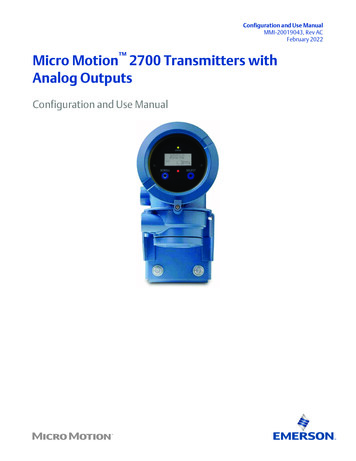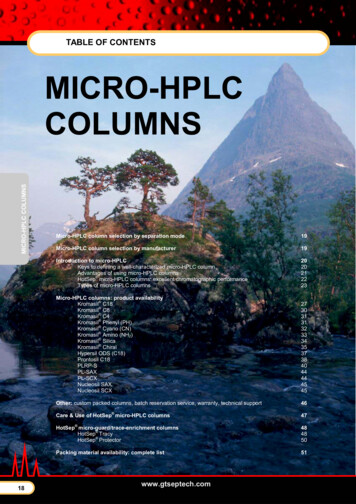
Transcription
Micro-Mobility, E-Scooters and Implications for Higher EducationJames FongChief Research Officer, UPCEADirector, UPCEA Center for Research and StrategyPaul McDermottResearch Assistant, UPCEAMaria LucchiResearch Assistant, UPCEAMay 20191
Introduction to the Micro-Mobility LandscapeGeneration Z and Millennials, coupled with favorable trends regarding renewable energy andresource sharing, are quickly fueling a change within the transportation landscape. Some havelabeled the phenomenon “micro-mobility.” This term originally referred to personal vehicles forone or two passengers with the most common example being a standard pedal bike. Now,however, it describes new forms of transportation that include docked bikes, e-bikes, e-scooters,and even skateboards or e-skateboards often used in an urban setting.E-bikes and e-scooters have emerged as primary options for riders looking for micro-mobility inlarge city markets. The first semblance of modern bikeshare was seen in Copenhagen in 1995.1However, it took 15 years for large-scale adoption of the bikesharing practice in the U.S., withWashington D.C. launching Capital Bikeshare as a commitment to the bikeshare model, replacingthe pilot program launched two years earlier.2 In 2013, New York city launched its corporatesponsorship funding bikeshare program, a unique model using no public funds.3 That year,Chicago and San Francisco also launched their bikesharing programs.4 The key features of thesebikesharing systems were dock stations and monthly membership fees.It was not until 2017 that the defining feature of micro-mobility began to emerge: a docklesssystem. Private companies like LimeBikes and Vbikes launched their dockless bikes in citiesincluding San Francisco. However, in just a year, the dockless micro-mobility model has all butshifted to e-scooters. A pilot program in Washington D.C. originally had five companies offeringdockless bikes, with promises of expanding the bike-sharing market. By Spring 2018, the programhad almost completely shifted to e-scooters, with two of the biggest dockless bike operators,Mobike and Ofo, leaving the pilot that summer, citing an over-regulated market.5 At the sametime, dockless e-scooters became popular, with all but the Uber-owned company Jump choosingto fill its government-given allocation of micro-mobility vehicles exclusively with scooters.6 Manyother U.S. cities are following this trend. Shared pedal bikes are quickly disappearing in citiesincluding Seattle, Washington D.C., Dallas, Camden, Chicago, and Boston in 2018.Micro-mobility companies report that electric vehicles are much more popular for ridesharing,indicating that dockless e-bikes are twice as popular as standard bikes. Even more popular thandockless e-bikes are dockless e-scooters, with micro-mobility companies reporting that docklesse-scooters are two and a half times as popular among riders.7 These companies are respondingaccordingly. One of the biggest e-scooter companies, Lime, was originally called LimeBikes, butrebranded in May 2018, transitioning from dockless e-bikes to dockless e-scooters in May ions/bike-share/Ibid3 Ibid4 quire-locks-bikes-startingsaturday/?noredirect on&utm term .d29906c864f46 Ibid7 s-a-partnership-with-segway-300650581.html22
Among micro-mobility companies, e-scooters are seeing the highest rates of adoption in U.S.metropolitan areas. In under one year, e-scooters saw 3.6% growth, similar to the growth seenby ridesharing giants like Uber and Lyft.9 Bikesharing companies like Motivate have seen positivegrowth in the past eight years, but the future is uncertain. The adoption of bikesharing will see ahealthy bump due to the advent of the e-bike; however, bikesharing will also have a very largesegment of its market taken by the more popular e-scooter option. It is clear that e-scooters arethe dominant option in the micro-mobility market. Ridesharing options have all seen logarithmicgrowth, meaning that in eight years, the e-scooter market can expect to see much greater lineargrowth than 28.8%. Given these forecasts, the main focus of this paper will be on dockless escooters.Figure 1: Ridesharing Service Adoption by Years Since Launch10Source: Micro-Mobility Revolution, ity-revolution-95e396db3754Ibid103
Trends in Micro-MobilityDecreased Demand for Traditional VehiclesWith fewer cars on the road, there will be significantly less demand for parking spaces in urbanareas. This is especially important now considering young people are entering their adult lives ina time where housing prices are at an all-time high.11 The existing land supply crunch has drivenreal estate prices up; developers are able to hoard land and add a premium to propertypurchases and rentals. One of the most common uses of city land is for parking. Micro-mobilitywill ease this demand and therefore open up land supply. In a competitive market, this will driveland prices down, followed by a decrease in housing prices.Local governments across the world have already begun banning certain vehicles from their citycenters. For example, Madrid, Spain bars all non-resident private transportation from its citycenters.12 Oslo, Norway plans to permanently ban all vehicles from the city center this year.13Governments are doing this to reduce carbon emissions and congestion within their alreadyheavily populated urban regions. These cities could begin to take advantage of the micromobility trend in lieu of traditional vehicles for their citizens. This would further solidify thespread of micro-mobility globally.A Greener Way of TransportationNow more than ever, people, especially Gen Z’ers and Young Millennials, are becomingconscious of the impacts that their actions have on the environment. These young people areprepared to make a commitment to sustainability and will make the sustainable choice moreoften than not. Micro-mobility provides them with the opportunity to reduce the carbonfootprint. This aspect of the e-scooter and e-bike business model could be a driving force for itssuccess, especially among young people.The Expansion of Micro-Mobility Market ShareExpansion of the micro-mobility market has been rapid. Three of the four major e-scooterplayers were launched from February to May 2018, illustrating the boom. Both rideshare giants,Uber and Lyft, have made efforts to join the market, and Ford acquired Spin, an e-scootercompany. Additionally, e-bike companies are seeing dramatic growth. According to the NationalAssociation of City Transportation Officials, consumers took 84 million trips on shared micromobility vehicles in the United States in 2018, twice the number of trips taken in 2017 .14 Whileincreased regulation poses a significant hurdle to micro-mobility, the continued growth of theindustry is der.com/cities-going-car-free-ban-2017-813 ared-micromobility-2018/124
The Unbundling of Short to Medium Distance TransportationScooter companies like Bird have claimed that their main purpose is for “last-mile”transportation. Micro-mobility has essentially unbundled the first and the last few miles of a trip,or the entire trip, depending on the length. For city dwellers, specifically in cities with subparpublic transportation, rideshare e-scooters represent a viable and affordable way to travel, evenif it is only the first or the last mile. For businesses, last mile logistics can often make up 28% oftotal shipping costs.15 Because the micro-mobility market offers solutions in last-miletransportation, there is potential for businesses and small delivery firms to take advantage of escooters, further perpetuating their popularity. Not only would this reduce costs for both thefirm and the consumer, but it would reduce carbon emissions and city congestion as well.A New Data-Driven Fold to City PlanningMicro-mobility has the potential to spur a revolution in city planning and the overall look of U.S.cities over the next 10 to 20 years. With built in GPS’s, scooter and e-bike companies are able totrack every trip. At the end of each ride, the user is shown a map of their ride, detailing lengthboth in time and in distance. This data will be invaluable to city planners who are adapting citiesdue to the advent of micro-mobility. These planners will have tangible insight into the mostcommon routes travelers take in their cities. The advent of cars caused city streets to widen andsidewalks to shrink, but micro-mobility options could lead to a reversal. In planning thesemodern-day cities, the data-provided by micro-mobility companies will dictate the newtransportation grids. Micro-mobility is the beginning of a city planning revolution. The youngpeople of today will likely live in cities with vastly different street and transportation makeups inthe near e-logistics/5
E-Scooters: An Example of the Expansion of Micro-MobilityDockless scooters present an entirely new type of short-distance transportation. Riders are freeto park their scooters anywhere. Starting a ride is just as easy. The rider scans the QR codelocated on the handlebar of the scooter, and the scooter activates. Riding off without scanningwill result in a fairly jarring and unrelenting jingle to attack the rider’s ears. This simple yeteffective mechanism parallels the business model as a whole. There is almost no barrier to entryfor any individual ride, no waiting at a curb and keeping your eyes peeled for a specific make ormodel. The only barrier is the availability of a scooter, which will prove to be less and less of aproblem as more scooters are deployed.How it works:-Riders sign up on a smartphone app. Some require a driver’s license; all require paymentinformation.-Using the app, riders can locate the scooters visually on the map provided on the app.Every scooter is equipped with GPS technology, allowing the app to keep tabs on all thescooters at all times. Riders can ring the scooter if they see it on the map but are havingtrouble finding it.-To start a ride, the rider scans a QR code located on the handlebar from the phone app.-Riders pay “ 1 to activate a scooter and then 20 cents per minute. Rides usually stretchfrom a half-mile to a bit more than a mile.”16-On a flat road, the scooters can reach speeds of about 16 mph, with a trigger on thehandlebar allowing the rider to control how much “gas” they give the scooter.-Upon completion, riders go to the app and touch “End Ride.” Then the rider must take apicture of the scooter in case the next rider needs help locating it. Riders can also pausetheir rides. This avoids the 1 activation charge when they come back to the scooter.-To recharge the scooters, the rideshare companies hire contractors who drive aroundpicking up the scooters to recharge in bulk, and later place the scooters back in ng-for-lime-and-bird/article b2036edf-e54c-5ab7-bd1fc668fc47ede4.html176
The Major PlayersElectric scooter sharing companies are beginning to flood the market, trying to stake a claim onmarket share before saturation. Bird was first on the scene and was quickly followed by Lime,Spin, and Skip.Figure 2: Major E-Scooter Companies18BirdFounded by ex-Uber and Lyft man, TravisVanderzander, the first ten Birds were deployed inSanta Monica in September 2017.SpinInitially a bikesharing company, Spin announced itsventure into electric scooters in February 2018.Later bought by Ford for close to 100 million.18LimeInitially only offering bikesharing, Limeexpanded to electric scooters inFebruary 2018.SkipSkip was a bit of a latecomer to the market,launching in March 2018, founded by e-electric-scooter-wars-of-2018/7
The Scooter TimelineAfter Bird’s initial September 2017 launch, companies started announcing its plans for electricscooter rideshare in quick succession. From February to May 2018, four separate companiesannounced their intention to enter the electric scooter rideshare market.19 The establishedrideshare and automotive companies quickly took notice. In November 2018, Ford decided tobuy Spin20 in a deal worth almost 100 million.21 Uber has partnered with Lime22, in a deal thatimplemented Lime into Uber’s app, allowing riders to find Lime scooters.23 Uber is alsoreportedly interested in buying a scooter rideshare company outright; however, Bird has made itclear that it is not for sale, leaving Lime as the primary option.24 Additionally, Uber recentlyacquired a bikesharing company, Jump.25 The other rideshare giant, Lyft, is also looking to makea scooter play in an attempt to expand horizontally.26 Neither has made their play yet, but theirentrance into the market indicates that the first phase of market entry is likely coming to an end,and consolidation of market share is likely.Figure 3: The Scooter nto-scooter-sharing/21 ip-with-segway-300650581.html23 oter-wars-of-2018/24 Ibid25 208
Why Does It Matter?To understand micro-mobility’s leap onto the ridesharing scene, some of the key benefits thatcome with the business model must be examined.-“Short, single-occupancy car trips represent 80 to 90 percent of all automobile travel.”27Electric scooters are well suited for these types of trips.-Scooters can contribute to greener cities because they have the ability to take cars offthe road and provide a much greener alternative. According to Medium.com “producingelectricity for five million scooters around the world would emit 370 metric tons, which isless than 2% of CO2 produced by the same number of cars. Let’s reduce this number by20% for people who would have walked and for chargers picking up scooters in their cars.Now we’re looking at a total amount of 13,700 metric tons of CO2 mitigated by notdriving a car. That’s the equivalent of taking 105,000 cars off the roads around the world,each day.”28-By taking cars off the road, scooters also have the potential to decongest city roads,replacing cars for short single occupancy rides.29-The scooter industry calls its offerings “last mile” transportation. Potential riders utilizemajor public transportation methods such as a subway or bus and then scooter to theirfinal destination, or vice versa.30 In this way, scooters can be seen as an extension ofpublic transportation.-These scooters are suited for areas with limited parking due to their dockless nature,eliminating the need to drive around looking for parking.-They are well suited for areas not meant for heavy car-traffic, or in populated areaswhere traffic is congested, such as college campuses, bike trails, and busy city ric-scooters-8da806939a3229 -be-coming-to-new-york/289
Scaled up to 500 cities with electric scooter ridesharing, and taking into account the energyneeded to recharge, scooters mitigate about 13,700 metric tons of CO2 a day.Figure 4: Scooter Sustainability31Scooters mitigateThis is equivalent to Removing 13,700 metrictons of CO2105,000carsa dayfrom the road dailySource: The Environmental Impact of Electric Scooters, 2018Obstacles to the Future of Micro-MobilityDespite the advantages that dockless scooters can bring to a city, there are also considerabledisadvantages including a lack of regulation, increased congestion, and limited liability. Localgovernments have been fighting them and their parent companies for the various issues thatthey create.Lack of Regulation & NoticeMany of the start-ups mentioned, developed their technology without consulting thegovernments that the business would be affecting. There was no opportunity for regulations tobe created, reviewed, and passed in order to control the use of the dockless scooters. Therefore,cities became inundated with the scooters being left haphazardly with little concern for dailygovernment functions such as trash collection and street cleaning. Additionally, localgovernments were concerned that without proper regulation, there would be no way for themto collect taxes or fees from the start-up companies to help maintain the city infrastructure androad quality.Misuse Causing CongestionAs the dockless scooters flooded cities across the nation without proper "stations" or "docks,"they began to create the very problem that they were supposed to solve: congestion. Asconsumers left the scooters wherever they pleased, sidewalks and public spaces becamecluttered with scooters, making the city even more 939a3210
Liability ConcernsAdditionally, dockless scooters pose serious liability issues for both the local governments andthose who use them. Although consumers sign a liability waiver when they use a docklessscooter, there is concern over whether or not there is any insurance coverage on these devicesin case of accident or injury to the user or especially a bystander.32 These scooters can reachspeeds of 15-25mph, fast enough to cause life-changing injuries to any party involved in anaccident. In cities where dockless scooters have been permitted, there has been an uptick ininjuries and accidents related to this technology.33Scenes such as this one led the city of Austin tosuspended giving new licenses to micro-mobilitycompanies in January.Police officials in Austin have made a concertedeffort to prevent scooters from operating on certainkey streets.Furthermore, the Center for Disease Control (CDC) released a report on May 2, 2019 detailingstatistics related to e-scooters and injuries. The report found that injuries occur roughly 14.3times per every 100,000 trips. The CDC found that head injuries were the most common type ofinjury (45%), followed by upper extremity fractures (27%) and lower extremity fractures (12%).The report suggested that many of the injuries could have been prevented if riders were wearinghelmets and were more careful around th-helmets.html3311
Micro-Mobility and its Implications for Generation Z and YoungMillennialsPeople have a positive perception of dockless scooters. A study carried out by Populus Insightsfound that 70% of people in major cities with scooters available view them positively. Thepositive aspects highlighted in the survey are the scooter’s ability to provide transportationwithout the hassle of owning a car, provide logical short transportation options, andcomplement public transportation.Figure 5: Public Perception of Micro-Mobility in Major U.S. CitiesAs one of the first cities to see e-scooters, San Francisco has experienced growing pains inregards to micro-mobility. Accordingly, the local government has implemented variousregulations to hinder micro-mobility’s growth. However, the public perception data shows thatSan Francisco could in fact be an outlier, likely due to the fact that it was a test market. SanFrancisco residents have by far the lowest opinion of e-scooters, with only 52% percent of surveyrespondents indicating a positive view towards the scooters.35 This is a full 15% lower than thenext lowest city (New York), which could mean that some of the growing pains have alreadystarted to be alleviated either by the companies themselves, or the various local governments.Figure 6: Public Perception of E-Scooters by U.S. CitySource: Populus Groundtruth, uly12
The Unbundling of TransportationScooters appear to be more than a passing fad in transportation. Cities cannot ignore thegrowing influence of micro-mobility, and must find a way to work with the companies and toaccommodate the scooters. Micro-mobility essentially unbundles the first or last few miles fromthe car, bus or train ride. The radius for parking a car is vastly expanded for drivers, as is theradius of realistic bus and train stations for riders to either hop on or hop off their choice ofpublic transportation. Scooters provide an affordable way for people to greatly expand theirradius of availability for travel, either with pure scooter rides, or a combination of modes. This atface value is a huge positive, but it also brings into play a lesser discussed benefit of micromobility: transportation equity. Purchasing a car is a pricey endeavor and one that is gettingmore and more difficult for recent college grads and people of lower income. And coincidingwith this, Populus Insights found that there is an overall negative relationship between incomeand perception of e-scooters.36Figure 7: Public Perception of E-Scooters by IncomeSource: Populus Groundtruth, 2018The explanation behind this perception is likely very simple: scooters are much less expensive touse than cars. This is only compounded by the ownership costs of cars. In addition to making thescooters appealing to new graduates, this factor will also heavily contribute to student adoptionof micro-mobility options. College students will no longer be limited to a one- to two-mile radiusof their dorm or apartment and will no longer have to settle for what can be an expensive Uberor Lyft trip across campus.The Repurposing of City SpaceWith the student debt crisis, higher rents, uncertain employment prospects, and the tightenedmortgage market, young people are buying homes at a much lower rate than older generations.According to the Urban Institute, the homeownership rate for millennials was 37 percent in2015, eight percentage points lower than the two previous generations at the same age.37 Aland supply crunch has allowed property developers to purchase land to flip at a high margin forapartment rentals and business leasing. Similarly, housing prices are going up in part due to thetightened mortgage market. Using San Francisco as an example, the distribution of home saleprices from 2007 to 2017 shifted significantly towards the more expensive end of the g-homes3713
Figure 8: Distribution of Home Sales Prices in San FranciscoThis trend is not limited to only San Francisco, however. The U.S. Federal Housing FinanceAgency keeps an index of housing prices. Figure 9 shows how indexed housing prices have beenincreasing since 2012 and are now at an all-time high. Again, a large driver of this is a land supplycrunch.39Figure 9: House Price Index for the United States, /series/USSTHPI14
Two hundred square miles are dedicated to parking in Los Angeles.41 This is in a cityencompassing a total of 502.7 square miles, meaning that about 40% of Los Angeles is reservedfor parking.42 E-scooters provide cities with the opportunity to repurpose some of this land dueto lower demand for parking. This increase in land supply will drive down land prices, whichcould carry over to lower housing costs in cities, something that young people need.Figure 10: Implications of Lower Demand for Parking in CitiesLandSupplyParkingDemandHousingPricesImpact on the Job MarketWhere does micro-mobility fit into the job market of today and the future?Micro-mobility companies have seen heavy early investment from investment institutions as wellas some of the established transportation companies like Ford. As of January 2019, four micromobility companies were able to raise over 100 million in investments, with Bird and Limeseeing funding similar to giants like Lyft and Uber.Figure 11: Funding for Ridesharing Companies43Source: The Electric Scooter Wars of tteer/2010 place list tric-scooter-wars-of-2018/4215
By observing the occupational data on three e-scooter companies, Lime, Spin and Skip, valuableinsight can be gained into what kind of jobs these newly established micro-mobility companiesare creating. Figure 12 highlights the top occupations posted from March 2018 to March 2019among these three organizations. The top occupations include computer user supportspecialists, general and operations managers, maintenance and repair workers, and businessoperations specialists, all other. It appears that these companies which are built on a mix ofhardware and software are still focusing on user experience, but now have a need for businessprofessionals as well as customer service professionals and those who are able to fix andmaintain their product. As these companies scale, they appear to be looking for professionalswith the business knowledge to bring efficiency to their supply chain and avoid the costlymistakes that are routinely made when companies rapidly expand. Public relations specialistsand public relations and fundraising managers are also included in the top posted occupations,likely as micro-mobility companies now need to leverage a strong public perception intoeffective lobbying among consumers and city officials as well as to boost participation numbers.Figure 12: Top Posted Occupations by Select Micro-Mobility CompaniesSource: Economic Modeling Specialists International (EMSI) 2019.1 DatasetFigure 13 on the following page illustrates the top 10 hard-skills sought by Lime, Spin, and Skipfrom March 2018 to March 2019. As the three companies continue to grow, they appear to beplacing an increased emphasis on operations management, warehousing, and mechanics, whilestill focusing on the core software and hardware requirements necessary to maintain theirmicro-mobility offerings.16
Figure 13: Top Hard Skills for All Job Types Sought by Select CompaniesSource: Economic Modeling Specialists International (EMSI) 2019.1 DatasetWhile the three previously highlighted companies provide insight into specific micro-mobilitycompanies, it is important to also have a broader understanding of the micro-mobility landscape.To achieve this, job posting keyword data was examined. Nationwide, from March 2018 toMarch 2019, there were a total of 35,726 job postings with the keywords “Micro-Mobility”, “EScooter”, or “Bikesharing”, with 8,632 of them being unique. The intensity for these postings was4:1, the same as the national average. Posting length was 30% longer than the average for theregion, meaning that many of these postings require a more specific skillset and thereforecompanies will wait longer for the right candidate.Figure 14: Job Postings Overview that Contain “Micro-Mobility”, “e-Scooter”, or “Bikesharing”Across All Occupations in the United StatesSource: Economic Modeling Specialists International (EMSI) 2019.1 Dataset17
Figure 15 provides a geographic footprint of the job posting overview displayed in Figure 14.California had the highest number of unique postings (1,865), followed by Texas (769), and NewYork (759). This could be due to the fact that the first dockless e-scooter rollout was in SantaMonica and the prominence of the tech industry within the state,44 and Texas has multiple majormarkets including Austin, Houston, and Dallas. The Virginia/Maryland/D.C. area is also poised forgrowth due to the fact that the D.C. Board of Transportation recently granted provisional permitsto eight micro-mobility companies.45Figure 15: Job Postings by State that Contain “Micro-Mobility”, “e-Scooter”, or “Bikesharing”Across All Occupations in the United StatesSource: Economic Modeling Specialists International (EMSI) 2019.1 DatasetFigure 16 on the following page lists the companies with the most job postings containing theselected keywords from March 2018 to March 2019. Ingram Micro had the most unique postings(1,028), followed by Lime (628), and Limey Bikes (487). In addition to companies that are focusedon micro-mobility, software, and information technology, the list also includes companiesrelated to cybersecurity. Cybersecurity companies are gearing up for an increase in demand fortheir services specificall
mobility vehicles in the United States in 2018, twice the number of trips taken in 2017 .14 While increased regulation poses a significant hurdle to micro-mobility, the continued growth of the . - Riders sign up on a smartphone app. Some require a driver's license; all require payment information. - Using the app, riders can locate the .
